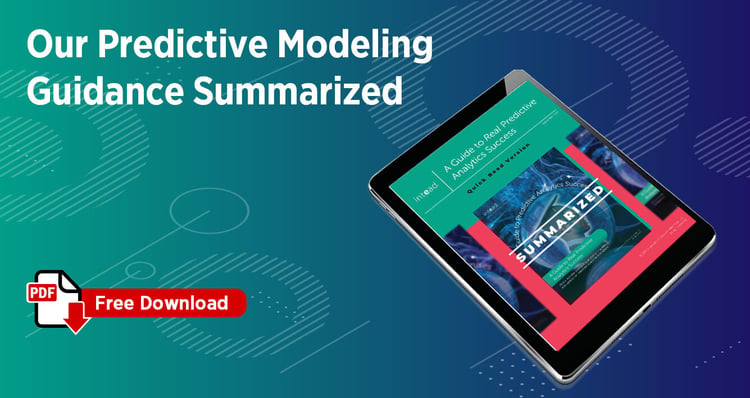
Does the rise of AI change the value of predictive analytics?
In 2020 we were all looking for a little predictability and sustainability. In life as well as enrollment. And while the pandemic may be in our rearview mirror, uncertainty remains an unflappable friend. We’re looking at you, enrollment cliff and public opinion polls about the value of higher education.
So, we thought now is a great time to revisit one of our most popular downloads because it’s all about predictability.
We published The End of False Promises: A Guide to Real Predictive Analytics ebook during the height of the pandemic as a tool to help our colleagues understand the role Big Data and Artificial Intelligence can play in enrollment strategies. After all, we know you’re increasingly looking for data to help deliver reliable, cost-effective, and transformational results for your institution. And we’re here to make sure you get what you think you’re paying for.
If you want to chat about how you are building your Fall 2024 strategy or the tactical execution approaches we have found most valuable, Ben and Iliana will be at the NACAC conference presenting alongside our colleagues from AIRC and Middle Tennessee State University on Sept. 22 in Baltimore. Can we schedule a time to chat? Send us an email and coffee's on us!
About our predictive analytics guide, you will:
- Decode predictive analytics
- Access case studies of predictive analytics in action
- Learn how to dodge prediction pitfalls
- Get your hands on a vendor vetting checklist
- And much more
The full guide is available on demand for Intead Plus members, while, you, our blog subscribers, can download a useful 3-page summary for free. Read on for access and a quick primer on what predictive analytics is and is not…
Predictive analytics is many things, but it’s important to understand that it’s not everything.
Download Intead’s 3-page Predictive Analytics Summary 
Officially, predictive analytics or modeling is “the use of data, statistical algorithms and machine learning techniques to identify the likelihood of future outcomes based on historical data,” with the goal to “go beyond knowing what has happened to providing a best assessment of what will happen in the future.” (SAS)
The big predictive analytics success story, Georgia State University, has used data-powered interventions to improve its four-year graduation rates by 7% points since 2012 and produce revenue gains in the multi-millions as a result.
Predictive analytics can...
- Identify the students most likely to enroll and succeed at an institution.
- Optimize the value and quantity of financial aid packages offered to meet enrollment goals (think price optimization).
- Identify students’ learning deficits to customize the pace, structure, and method of information delivery.
- Identify struggling and at-risk students through GPA, academic, and other campus activity monitoring to indicate valuable early interventions and tailored student advising.
- Support student success initiatives to improve retention and graduation rates.
But it’s not Big Data.
Thousands of student data points are nothing without the statistical modeling and technical expertise required to put this data into action. To implement successful predictive analytics tools and data-powered interventions into your strategy, you need human power (IT, analysis, enrollment staff, etc.) to put those insights into action. This is often where institutions fall short. Fortunately, this is where our team can offer useful counsel. Be in touch.
Predictive analytics can be used to steer your institution toward predictable enrollment and steady revenue streams in a manageable way.
What we’ve witnessed in our engagements are academic leaders who are understandably unsure of how to integrate this kind of analytics into their systems and processes and suffering budget constraints that limit the opportunities. Sound familiar?
In our ebook, we offer concrete and transformational ways to use artificial intelligence and machine-learning tools in enrollment, admissions, and student services settings. We present a manageable and modular approach that allows incremental investment and progress.
Predictive analytics can also help you achieve a more diverse campus, but beware of predictive pitfalls.
Criteria for best-fit students transcend economic status, race, gender, orientation, and other factors. To achieve true student success, your predictive model must go beyond the demographics of your current student composition and include a wider, and carefully selected range of student success indicators.
And this is where it can get tricky.
Much like human behavior, predictive models rely on past data to predict future behavior. Predictive modeling, particularly in the admissions part of the funnel, relies on the success of past students to identify similar prospects that are the most likely to succeed, creating a model of what a “good” student should look like. See a problem?
Exactly. If the same types of students have always succeeded, those same students will continue to be groomed and fostered for success within the same institutions and down the same paths of study. Predictive models, if wielded carelessly in the admissions process may only serve to reinforce those inequities, not to mention degrade the rich learning environment of diverse thought and perspectives that you strive to offer your student.
Word to the wise: Evaluate your predictive admissions models with a critical eye to build diversity and avoid reinforcing a more homogenous student body.
Download our summary with the link below and be in touch if you’d like to explore the topic with our team.
Download Intead’s 3-page Predictive Modeling Summary 



